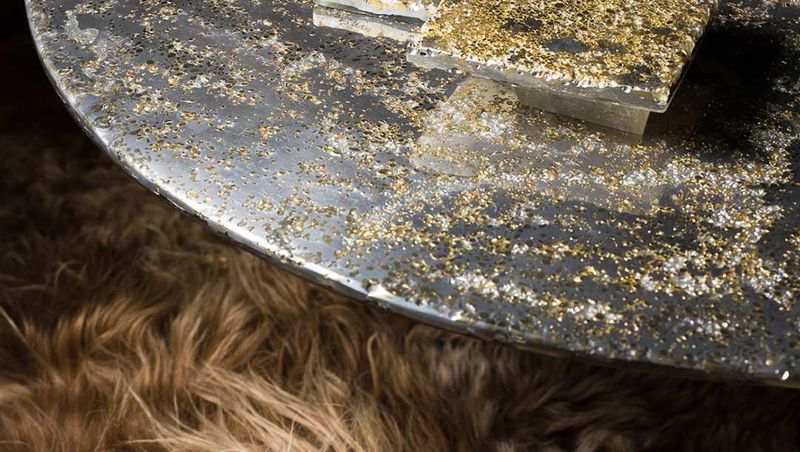
Sunshine Table in shades of brown, gold, and white. Thanks to a controlled environment, brass pellets are able to be submerged in pewter.
Image courtesy of: Maison Objet
Xavier Lavergne has spent the past twenty five years working on prestigious architectural projects; including the European Commission headquarters in Brussels, on which he worked alongside Jean Nouvel, and Osaka’s French Pavilion. The Frenchman’s most ambitious undertaking however was commandeering a large-scale construction and renovation project at the Chateau de Versailles, this enterprise started in 2010 and lasted for seven years.
Since opening his own architectural practice in 1998, Lavergne has reveled working with master artists. At Versailles, the architect was thrilled to collaborate with glassmakers, carpenters, stonemasons, and roofers that he quickly grew to respect immensely.
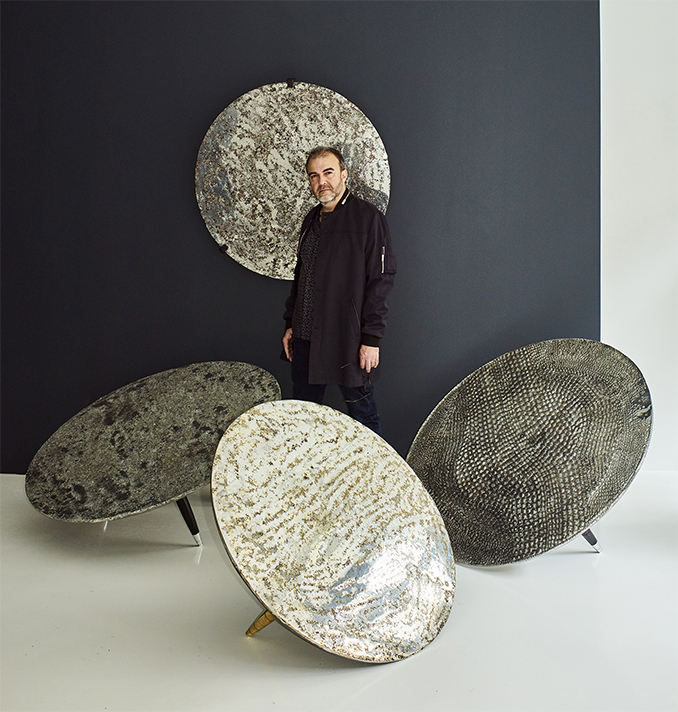
The designer with a sampling of his tabletops. The process is accomplished by “subjecting melted pewter to hot-cold thermal shock.”
Image courtesy of: 1st Dibs, photographed by: Didier Delmas
In 2017, the architect opened a luxurious workshop and showroom in Paris’ former textile district called Xavier Lavergne Ateliers. This move was prompted by two things; a desire to continue working with master artisans and a growing frustration with the French government’s stringent guidelines imposed on working on historic landmarks. He told 1st Dibs, “I began to experiment, crafting them myself, like an alchemist, in a meticulous process of testing and researching, inventing my own ‘tools’- not just objects but also gestures and ideas. My goal was to begin imagining new materials and designs that could play a role in building a sort of contemporary Versailles.”
The furniture lines under the Ateliers’ umbrella include tabletops, coffee tables, side tables, and consoles made of melted pewter and resin. The pieces are further adorned with bronze casting grains or Murano bead flakes using a method Lavergne has been perfecting for close to twenty years.
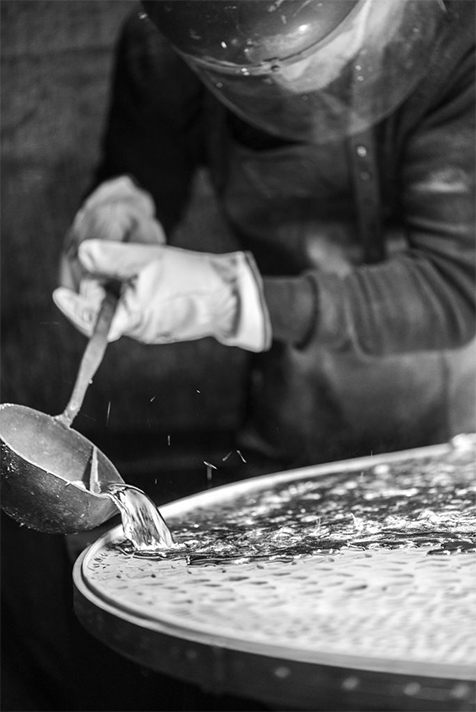
Lavergne creating his Totem Scales Tables.
Image courtesy of: 1st Dibs, photographed by: Romain Mallet
Some believe that Lavergne’s pieces resemble what outer space looks like… the fact that his collections are named Star Dust, Bio-Stars, Galaxy, and Meteors (among others) further cements that idea. The more luminous the piece, the closer the connection to both the tangible, such as an alligator’s skin and the intangible, similar to extraterrestrial skies.
There is a “hidden,” winding staircase in Lavergne’s studio that leads downstairs to a workshop where Lavergne experiments with mixing, heating, and cooling techniques… hoping to further perfect them. To the naked eye, this might appear as a luxurious, over-the-top kitchen intended for “molecular gastronomy.” However at the forefront is pewter in its purest form, an alloy that has been used for many centuries. The central island is also filled with various containers of colored glass beads, copper, bronze, aluminum, and brass.
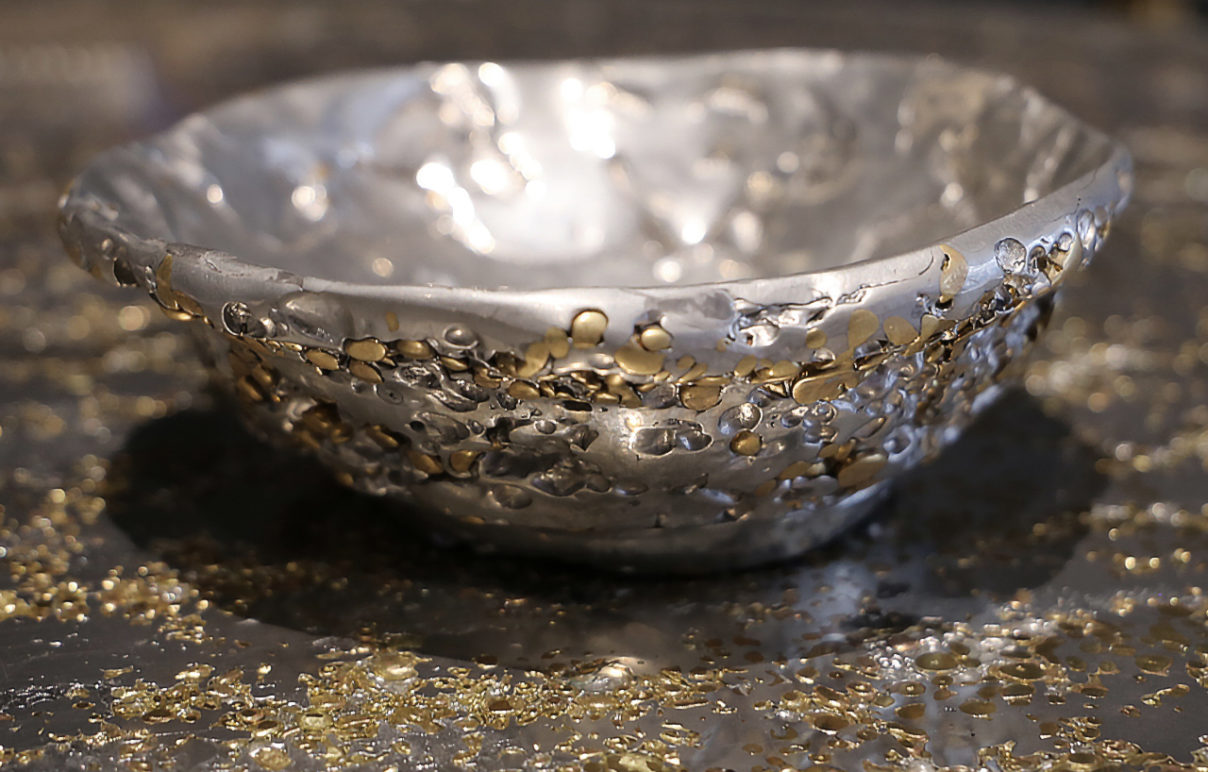
Meteorite Cup XLA2 is made of melted pewter with brass grains.
Image courtesy of: 1st Dibs
Lavergne chose pewter because it is extremely malleable. Thus, heat and humidity, in addition to pressure, can culminate in a variety of different appearances. He adds, “In its different states, it can be used as sheet metal, cast, bent, hammered, heated or molten. It can be frozen solid and combines with glass, minerals or other metals.” All of Lavergne’s pieces can be customized in regards to shape, dimension, height, width, and leg material.
The different “recipes” that the designer has created can be traced back to Lavergne’s desire to explore shadow and light within his tables’ surfaces. This process makes each creation unique and perhaps “alive?” He continues, “The alchemy is imperfect, so the result is often unexpected, never reproducible.”
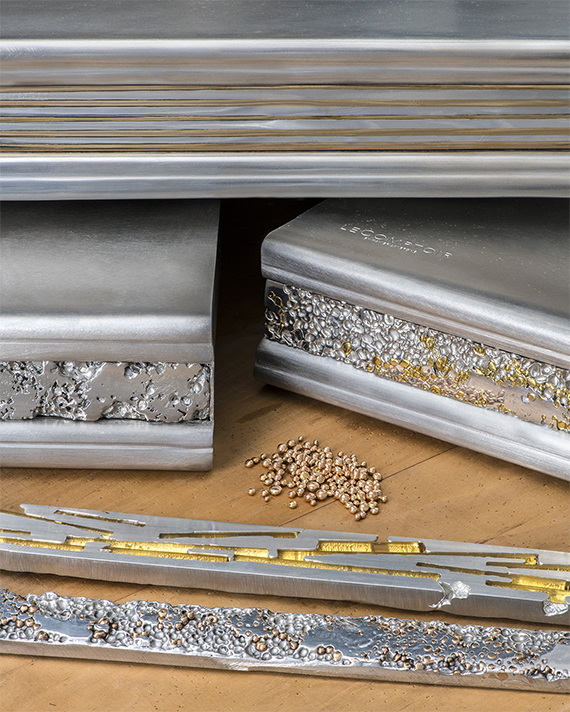
A sampling of table moldings by Le Comptoir.
Image courtesy of: Le Comptoir by Xavier Lavergne
Above the showroom resides Le Comptoir, Lavergne’s third space devoted entirely to creating pieces for the hospitality industry. The designer loves the history behind pewter and their place among France’s first cafes and restaurants. The vibrant material reached its height when King Louis XIV ordered his subjects to melt down their silverware in order to help recoup some of his losses from the war. Towards the end of the 19th-century, cafes, bistros, and bars started peppering Paris’ boulevards… food and drinks were served on wooden plank tables clad in pewter sheets. As more and more cafes opened, each one was committed to decorating their own tables with intricate moldings in order to impress their clients… and their competitors alike.
With this history, Lavergne realized that he needed a master pewter-smith to run his operation. The perfect partner was found to be at the helm of this budding business. Using his father’s tools, this artisan works with a number of apprentices to employ age-old pewter-working techniques in order to create beautiful pieces for some of the country’s most elite establishments.